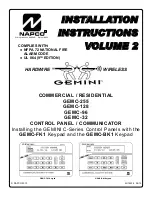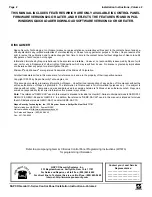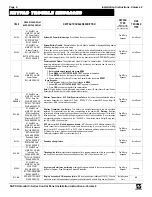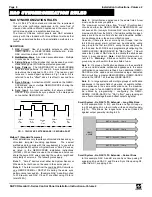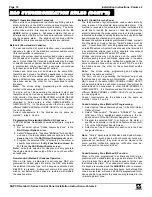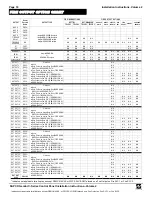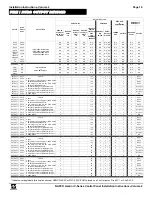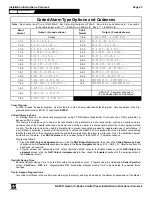
NAPCO Gemini C-Series Control Panel Installation Instructions--Volume 2
Page 10 Installation Instructions, Volume 2
NAC SYNCHRONIZATION RULES (CONT'D)
Method 1 Operation (Standard Temporal)
When a fire zone programmed to activate any NAC goes into
alarm, all horns on the NAC's will sound synchronized tem-
poral and all strobes will activate synchronously. The horns
will continue until a Fire keypad is unlocked and the
SI-
LENCE
button is pressed. Subsequent alarms that occur
after silence, but before all fire zones are restored, will reiniti-
ate the cadence alarm. The strobes will continue until the
RESET
button is pressed and all fire alarms are restored.
Method 2 (Non-standard Cadence)
The second method of synchronization uses non-standard
cadences in place of the standard temporal audible alarm
(this configuration is uncommon).
Because the system requires synchronized strobes, compati-
ble Wheelock or System Sensor "Smart" strobes must be
used. Conventional 24V sounding appliances may be used
or listed Wheelock or System Sensor devices that provide for
a synchronized strobe input and a separate conventional
horn input (such as the Wheelock MT series).
Strobes and horns may not be shared on the same NAC,
therefore each group of notification appliances in the same
field of view and all audible notification appliances in the
same notification zone will require at least 2 NAC's, one for
the strobe device, the other for the conventional audible
sounders.
Note:
The strobe wiring, programming and configuring
method is the same as method 1.
The horn will not be generating the temporal output and
therefore does not require synchronization. Horns on the
NAC circuits of the same GEMC-XXXMB or GEMC-NACXX
will be synchronized to each other; but they will not be syn-
chronized to horns wired to other GEMC-XXXMB's or
GEMC-NACXX's.
It is therefore advised that horns wired to
different GEMC-XXXMB's or GEMC-NACXX's not be placed
too close together.
Current requirements for the strobes are the same as
method 1, rules 2, 3 and 4.
Programming Non-standard (Method 2) Cadences
In PCD-Windows Quickloader download software, program
as follows:
1. Do not select option "Coded Alarms by Zone" in the
NAC/Output Options
screen;
2. Select "Silence-able, "Cadence "ENABLE" for each NAC
and one of the four available cadence options in the
Ca-
dence
column of the
NAC/Output Assignment
screen;
3. Program the selected NAC to activate on fire alarm or
specific zone alarms in the
By Zone feature screen (A-
D, 1-8) or the NAC/Output Events screen
Note:
All outputs selected for Cadence will only generate
the single selected cadence type. NAC's can not have differ-
ent cadences.
Non-standard (Method 2) Cadence Operation:
When a fire zone, programmed to activate any NAC pro-
grammed for Coded, goes into alarm, the NAC will produce
the selected Cadence type until a keypad is unlocked and
SILENCE is pressed. Subsequent alarms that occur after
silence, but before all fire zones are restored will reinitiate
the cadence alarm.
Method 3 (Coded Alarm by Zone)
The third method of synchronization uses
coded alarms by
zone
in place of the standard temporal audible alarm. This
method is requested for schools and other institutions that
would like to identify the device or zone that initiated the
alarm to determine the proper egress route or to allow proper
instructed authorities to quickly determine if a pull station had
been improperly activated prior to evacuation.
Because the system requires synchronized strobes, compati-
ble Wheelock or System Sensor "Smart" strobes must be
used. Conventional 24V sounding appliances may be used
or listed Wheelock or System Sensor devices that provide for
a synchronized strobe input and a separate conventional
horn input (such as the Wheelock MT series).
Strobes and Horns may not be shared on the same NAC,
therefore each group of notification appliances in the same
field of view and all audible notification appliances in the
same notification zone will require at least 2 NAC's, one for
the Strobe device, the other for the conventional audible
sounders.
Note:
The strobe wiring, programming and configuring
method is the same as method 1.
The horn will not be generating the temporal output and
therefore does not require synchronization. Horns on the
NAC circuits of the same GEMC-XXXMB or GEMC-NACXX
will be synchronized to each other, however, they will not be
synchronized to horns wired to other GEMC-XXXMB's or
GEMC-NACXX's.
It is therefore advised that horns wired to
different GEMC-XXXMB's or GEMC-NACXX's not be placed
too close together.
Current requirements for the strobes are the same as
method 1, rules 2, 3 and 4.
Coded Alarm by Zone (Method 3) Programming:
1. Select option "Coded Alarms by Zone" in the NAC/Output
Options Screen
2.
Select "Silence-able", "Cadence "ENABLE"" for each
NAC one of the 4 available cadence options in the Ca-
dence column of the NAC/Output Assignment screen.
3. Program the selected NAC to activate on fire alarm or
specific zone alarms in the By Zone feature screen (A-D,
1-8) or the NAC/Output Events Screen
4. Select one of the 31 cadences for each zone in the Zone
assignment screen.
Note:
"Smart" Synchronized Wheelock and System Sensor
horns are NOT synchronized with conventional horns pro-
grammed for temporal;
they must never be placed in the
same audible notification appliance notification zone be-
cause they will not be synchronized
.
Coded Alarm by Zone (Method 3) Function:
When a fire zone, programmed to activate any NAC(s) pro-
grammed with a coded alarm type, goes into alarm, the NAC
(s) will produce the selected Coded sequence for the zone
that initiated the alarm. The coded alarm will continue until a
fire keypad is unlocked and the
SILENCE
button is pressed.
Subsequent alarms that occur after silence, but before all fire
zones are restored, will cause all NAC's programmed for ca-
dence enable to generate the cadence programmed for the
re-initiating alarm zone.

